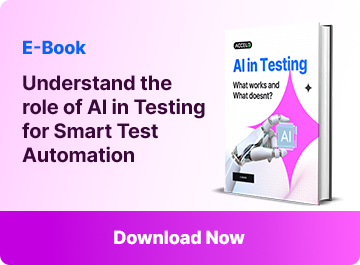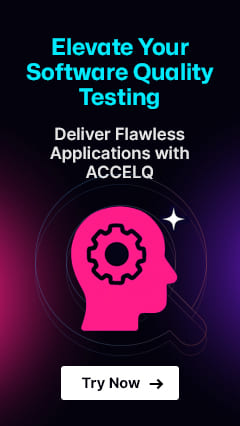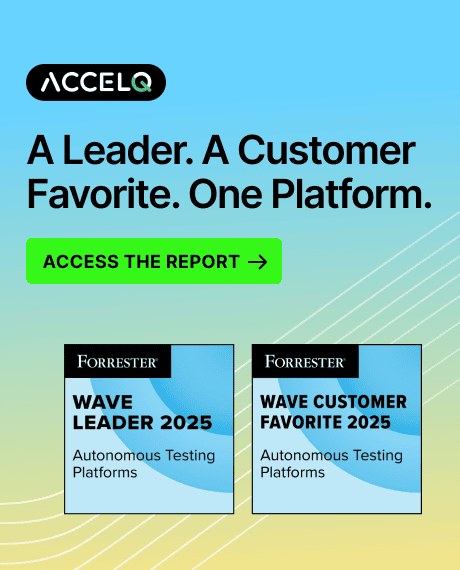AI-Prioritized Regression Testing: Smarter Coverage, Faster Delivery

As software development and delivery cycles shrink and business prospects increase, outdated regression testing often finds it difficult to keep up. Testing each functionality manually or running huge automated suites takes up important time, postponing releases and raising charges. That’s where AI for regression testing is reforming QA (quality assurance).
AI in regression testing identifies the most business-critical areas impacted by recent alterations and ensures they are assessed first through intelligent prioritization and machine learning (ML). Teams may focus on extreme risk scenarios, get wiser coverage, and deliver quickly without sacrificing quality, rather than putting in place 1000s of recurring tests.
Regression testing with an AI focus isn’t just an optimization; it is a strategy shift that enables specialist teams to keep up with the rapid advancements in modern DevOps.
- The Problem with Traditional Regression Testing
- What Is AI-Prioritized Regression Testing?
- AI-Prioritized Regression Testing's Main Advantages
- How does AI improve regression testing coverage?
- How ACCELQ Enables AI-Prioritized Regression Testing
- Best Practices for AI-Driven Regression Implementation
- Why is AI better than traditional regression testing methods?
- AI vs Traditional Regression Testing
- Conclusion
The Problem with Traditional Regression Testing
Regression testing is crucial to guaranteeing that modifications in the new code do not break existing features. However, in old methods, this procedure rapidly becomes a glitch as apps scale. Every fresh release adds extra traits, dependencies, and integrations, leading to bloated suites that are tedious, repetitive, slow, and resource-centric.
Key Challenges with Traditional Regression Testing
- Time-Consuming Suites: Executing 1000s of manual or automated regression tests often takes some days or even weeks, postponing release timelines.
- High Maintenance Struggle: Keeping regression scripts updated to reflect User Interface (UI) modifications, integrations, or workflows necessitates significant effort.
- Low Risk Awareness: Outdated form of testing lacks the intelligence to detect which sections of the system are highly affected by code modifications, resulting in over-testing in some zones and under-testing in others.
- Redundant Test Coverage: Several test cases end up validating a similar functionality recurrently, wasting implementation time.
This is where modern, smart techniques such as AI for regression testing step in to change the process.
SUGGESTED READ - Top Regression Testing Tools
What is AI-Prioritized Regression Testing?
Regression testing AI is a sophisticated or modern method that uses smart algorithms and ML (machine learning) to optimize regression test implementation. Instead of executing each test case in a suite, AI scrutinizes code modifications, past error patterns, and business-critical systems to prioritize the extremely relevant test cases.
This confirms that the areas’s extremely likely to be affected by current changes are tested first, expediting responses and decreasing redundant effort. Regression testing AI enables faster releases with fewer defects leaking into production by switching from thorough testing to intelligent, risk-centric coverage.
AI-Prioritized Regression Testing’s Main Advantages
Accepting AI in regression testing presents a more adaptive, intelligent AI in QA method that balances risk and pace. Beyond saving time, it primarily alters how teams authenticate complicated apps.
Major Benefits of AI in Regression Testing

- Rapid Feedback Cycles: Focuses implementation on high-risk situations, radically cutting test times.
- Decreased Test Suite Bloat: Removes low-value or redundant test cases, increasing effectiveness.
- Intelligent Error Identification: Leverages predictive analytics to find flaws earlier in the cycle.
- Supports Next-Gen Practices: Improves modern methods such as AI visual regression testing, which flaws even subtle layout or User Interface (UI) changes.
- Enhanced Test Maintenance: Strongly updates test priorities as apps progress.
- Smooth Integration with DevOps: Naturally fits into CI/CD pipelines, backing up continuous testing and delivery.
How does AI improve regression testing coverage?
AI improves test coverage techniques by mapping test execution to zones with the maximum business and technical threat. Rather than blindly implementing every test case, it evaluates use patterns, impact, and error history to secure critical paths, and edge cases are tested first. This approach provides risk-attuned, broader coverage with lesser test executions, delivering smart coverage, fast delivery.
Meet Your Personal AI AUTOPILOT!
Testing at Hyperspeed Starts Here!
Try Now
How ACCELQ Enables AI-Prioritized Regression Testing?
This platform is purpose-built to bring agility and intelligence into regression testing. With its AI-centric automated testing platform, teams can radically prioritize regression test cases based on risk, code modifications, and business impact. Crucial capabilities ACCELQ offers for AI-listed regression testing:
- AI-centric Impact Analysis: Detects which areas of the app are likely to be affected by current changes.
- Intelligent Test Selection: Instead of the entire suite. It runs only the highly relevant regression tests, saving precious resources and time.
- Self-Healing Automation: Updates test scripts automatically when User Interface (UI) or system changes occur.
- E2E Coverage: Extends regression tests across API, mobile, web, and ERP systems.
Businesses can use AI for regression testing with confidence with ACCELQ, which also reduces cycle times and improves release quality.
Best Practices for AI-Driven Regression Implementation
AI implementation and Regression testing in Salesforce or other apps demand more than just tools; they necessitate a methodical approach that strikes a balance between risk, automation, and coverage.
Regression Testing Best Practices:
- Begin with High-Value Systems: Apply Artificial Intelligence (AI) & AI Agents to prioritize regression test cases with AI for crucial business processes first.
- Leverage Data-centric Insights: Utilize impact analysis and defect history to reform AI prioritization.
- Integrate with CI/CD Pipelines: Guarantee automated regression executes regularly alongside development for quick feedback.
- Maintain Baselines: Retain baselines updated for both AI visual regression testing and functional testing to avoid false positives.
- Examine and Adapt: Regularly scrutinize and review AI-centric test selections to confirm accuracy and business alignment.
By following these critical practices, experts can improve the effect of AI and regression testing and attain intelligent coverage at scale.
Why is AI better than traditional regression testing methods?
Artificial Intelligence (AI) is better than outdated regression testing as it removes redundancy, expedites implementation, and guarantees risk-based coverage. While old techniques run the full regression suite despite effect, AI in regression testing scrutinizes code changes, use patterns, and error history to prioritize the relevant test cases. This results in speedy feedback, minimized expenses, and high reliability in finding crucial defects.
What is the difference between traditional regression vs AI regression testing
The most common question software testing experts enquire is: Why is AI better than traditional regression testing methods?
Comparison: AI vs Traditional Regression Testing
| Aspect | Traditional Regression Testing | AI-Prioritized Regression Testing |
|---|---|---|
| Test Implementation | Executes a complete regression suite despite the impact. | Implements only impacted, high-threat regression cases. |
| Time Efficiency | Rapid cycles; focused on crucial paths. | Rapid cycles; concentrates on crucial paths. |
| Coverage | Redundant test coverage, sometimes uneven. | Risk-centric, adaptive, and intelligent test coverage. |
| Maintenance | Extra effort required for test script updates. | Self-healing automation reduces maintenance effort. |
| Error Identification | Reactive; problems found late in the cycle. | Predictive errors detected earlier using AI-centric insights. |
| Scalability | Struggles with complex applications and frequent releases. | Highly flexible for DevOps and regression testing in Agile settings. |
Why AI is better: Unlike outdated techniques, AI in regression testing ranks cases intelligently, expedites delivery, decreases redundancy, and guarantees intelligent coverage without compromising quality.
Conclusion
In the modern release cycles, depending entirely on traditional regression testing isn’t optional. AI-prioritized regression testing allows expert QA leaders to accomplish smarter coverage, find errors earlier, and expedite delivery without wasting resources or bloating test suites. By bringing intelligence into test assortment and implementation, companies can strike the perfect balance between quality and pace.
With ACCELQ’s codeless AI-centric test automation platform, enterprises can flawlessly adopt this advanced testing approach. From self-healing automation to impact-centric test prioritization, ACCELQ allows rapid releases, robust QA (quality assurance), and future-ready regression approaches.
Are you prepared to transform your regression testing with Artificial Intelligence (AI)? Contact ACCELQ no-code automation testing platform now to see how smart automation can fast-track your QA journey.
Geosley Andrades
Director, Product Evangelist at ACCELQ
Geosley is a Test Automation Evangelist and Community builder at ACCELQ. Being passionate about continuous learning, Geosley helps ACCELQ with innovative solutions to transform test automation to be simpler, more reliable, and sustainable for the real world.
You Might Also Like:
 Top AI Testing Frameworks QA Engineers Must Know in 2026
Top AI Testing Frameworks QA Engineers Must Know in 2026
Top AI Testing Frameworks QA Engineers Must Know in 2026
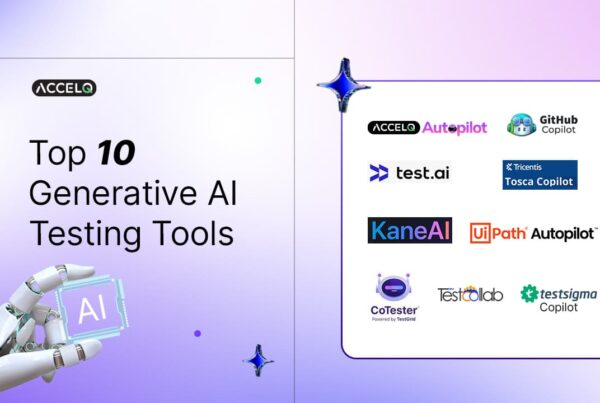 Top 10 Generative AI Testing Tools In 2025
Top 10 Generative AI Testing Tools In 2025
Top 10 Generative AI Testing Tools In 2025
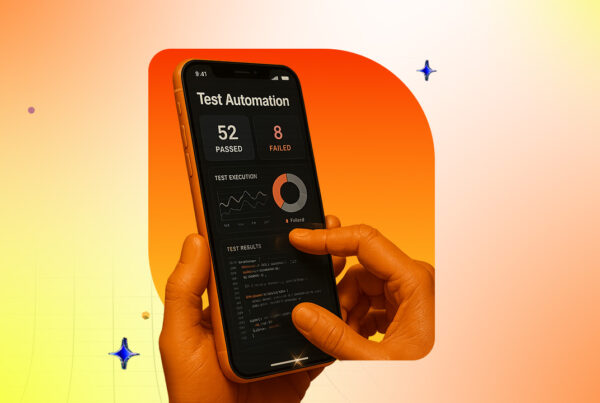 The Complete Guide To AI Mobile Testing
The Complete Guide To AI Mobile Testing
































